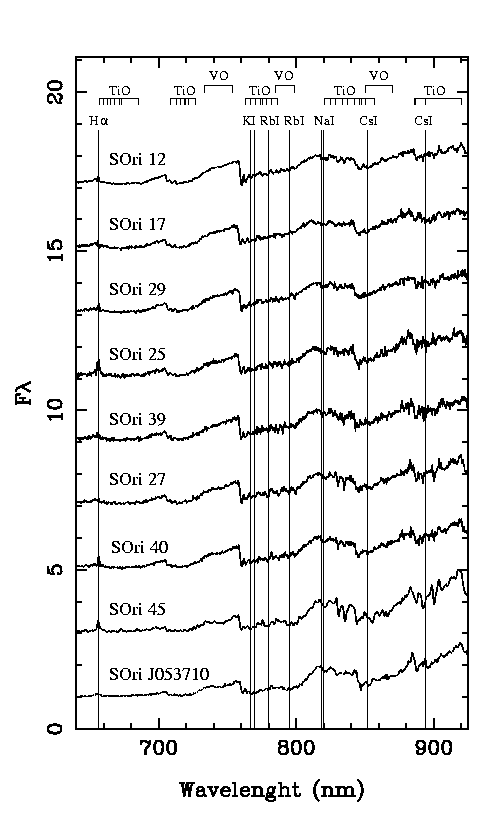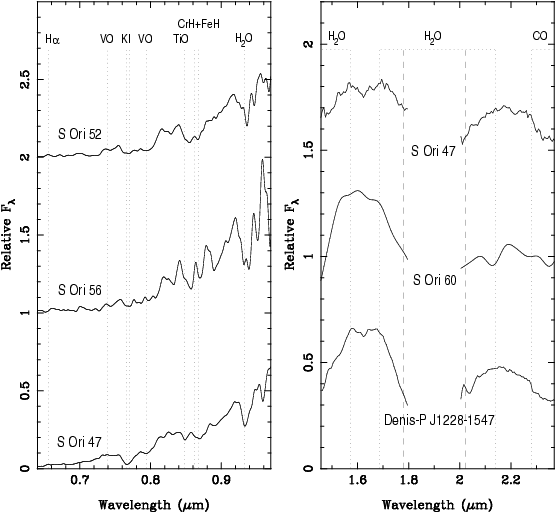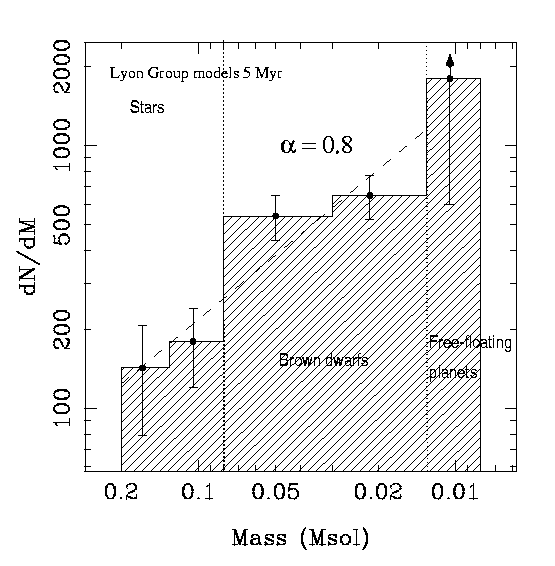2. Introduction
Sigma Orionis is a very young cluster 1-5 Myr, (Wolk & Walter 2000; Béjar et al. 1999, Zapatero Osorio et al.
2002). The distance to the cluster is known through the determination of the distance modulus of m-M = 7.7 +/- 0.7
to the central star, provided by Hipparcos.
The Sigma Orionis star is affected by a low extinction of E(B-V) = 0.05 (Lee 1968), thus, the
associated cluster is expected to exhibit very little reddening.
Our previous optical (RIZ) searches in the cluster led to the discovery of a numerous population of
low mass stars and brown dwarfs (Béjar et al. 1999). Follow-up infrared and spectroscopic data of these
candidates allow us to define the optical and infrared photometric sequences of the
cluster and a spectroscopic sequence of late M-type and early L-type members (Béjar et al. 1999;
Zapatero Osorio et al. 1999). This new "L" spectral class (Teff=2000-1500 K)
have been proposed for those objects cooler than M-type ones and is characterized by the presence of
intense alcaline absorption and the absent of TiO and VO.
Based on the successful results in this cluster we decided to performe
a deeper and more wide IZ survey in order to identify less massive substellar
objects (Béjar et al. 2000). The combination of optical and infrared observations have been proved as
the most powerful technique to identify these very faint and red objects, so we conducted a J-band
survey with the Omega instrument in the same region of our previous searches in collaboration with a group
from the MPIA in Heidelberg .
We report in this letter the determination of the Mass Function (MF) in the Sigma Orionis cluster which is
complete in the whole brown dwarf domain until the deuterium burning mass limit.
Our candidates have been selected from combined optical IZ and near-infrared J surveys
recently conducted around the central star in a region of 847 arcmin2 (Zapatero Osorio et
al. 2000; Béjar et al. 1999, 2000).
3. Photometric survey
New observations in the optical range were obtained with the Wide Field Camera
instrument mounted on the primary focus of the 2.5-m Isaac Newton Telescope at the
Roque de los Muchachos Observatory on 1998 November 12-13 (Béjar et al. 2000).
Images were bias-subtracted and flat-fielded using standard procedures within the IRAF environment.
Instrumental magnitudes
were transformed into observed magnitudes by differential photometry of objects in common with images
taken under photometric conditions with the IAC80 telescope (Teide Observatory), which were
calibrated in the Cousins system by observing Landolt's (Landolt 1992) standard stars at different
airmasses.
Near infrared photometry in the J-band has been acquired using the 3.5-m
telescope at the Calar Alto Observatory on 1998 October 27-31 (Zapatero Osorio et
al. 2000). Raw frames were reduced following
standard techniques in the infrared, which include sky-subtraction and flat-fielding.
The instrumental magnitudes were calibrated in the UKIRT system with faint standard stars
(Hunt et al. 1998) observed at different airmasses on the same nights.
In the 847 arcmin2 region under consideration we identify a total of 64 photometric candidates,
which seem to be very young objects and have magnitudes brighter and colors redder than the
10 Myr isochrone given by theoretical models (see Figure 1)

Figure 1. I vs. I-J color-magnitude diagram for the Sigma Orionis cluster. Selected candidates are indicated with filled circles. The 5 Myr isochrones from the Lyon Group (Next Gen models-full line- and Dusty models-dashed line), and from the Arizona group (dotted line) and the 10Myr Next Gen isochrone (full line, bluer than 5Myr) are also shown for comparison. Open circles around filled symbols denote candidates with available spectroscopy confirming their membership. Empty open circles are for members with spectroscopy but located outside of the 847 arcmin2, and thus not included in the MF computation. Completeness magnitude, spectral type, estimated temperatures and masses for the age of 5 Myr are also shown.
4. Spectroscopic follow-up and membership selection
Spectroscopic observations of a total of 24 of these candidates in
Sigma Orionis have confirmed 21 of them to be very cold objects with expected spectral types for
cluster members (see Béjar et al. 1999;
Zapatero Osorio et al. 1999, 2000; Barrado y Navascués et al. 2001; Martín et al. 2001). Some of them
show spectral features of low gravity objects, like Halpha in emission and less intense alkaline absorption,
confirming their youth.
These cluster members give a well defined spectroscopic sequence
from M6 (the most luminous and bluest targets) down to L6 (the reddest ones close to the
limiting magnitude of the survey). Several examples of the spectra obtained can be seen in Figures 2
(M-type objects) and Figure 3 (L-type), where the most important features are indicated.

Figure 2. Spectra of late M-type objects in the Sigma Orionis cluster. The most important features of this spectral type are indicated.

Figure 2. Spectra of L-type objects in the Sigma Orionis cluster. Optical spectra are shown in the left and infrared ones in the right. Infrared spectra of a well known L-type Denis object is also shown for comparison. The most important features of this new spectral type are indicated.
Available I and J-band observations for these objects
allow us to define the location of the low-mass star and brown dwarf
sequence of the cluster (Figure 1), which we will adopt as a reference for the
identification of cluster members. This location is suitably reproduced
by the combination of the 5 Myr ``dust-free and dusty'' Lyon models
(Baraffe et al. 1998; Chabrier et al. 2000)
as shown in Figure 1. Below I=20 we expect dust condensates
in the atmosphere of cluster members cooler than M9, and so the dusty models seem to be more appropriate.
The 64 selected photometric candidates are distributed along these theoretical and observational sequences
with a dispersion around 0.5 mag. (see Fig. 1)and we have a great confidence that the
mayority of these candidates (> 80 %) confirmed with infrared data are bona fide
members.
4. The substellar mass spectrum
In order to derive the masses of our candidates we have to compare their observed
magnitudes with those predicted by substellar evolutionary tracks given by the Lyon models (Baraffe
et al. 1998; Chabrier et al. 2000). In favor of these
models it can be argued that
they have been successful in fitting the mass--luminosity relation in various
optical and infrared
passbands (Baraffe et al. 1998; Delfosse et al. 2001), as well as in predicting coeval ages
for the members of several young multiple systems (White et al. 1999;
Luhman 1999), and that they provide a good fit to the infrared photometric sequence
in the Pleiades and Sigma Orionis clusters (Martín et al. 2000;
Zapatero Osorio et al. 2000).
The Sigma Orionis cluster substellar MF is illustrated in Figure 2, where the mass
spectrum representation (dN/dm) on a logarithmic scale is
provided. For the age of 5 Myr a single power-law fit (dN/dm ~ m-alpha)
facilitates a reasonable
representation of the data points with a slope of alpha= 0.8 +/- 0.4
in the mass range
which goes from very low mass stars (0.2 Msol) through the whole brown dwarf
domain to 0.013 Msol.
The uncertainty of +/- 0.4 in the alpha index accounts for possible
different ages of the
cluster and the use of other evolutionary models.
IMFs with slopes in the range 0.4-0.8 below the star-substellar mass borderline, have
been obtained recently for other young clusters (Luhman et al. 2000;
Lucas & Roche 2000; Hillenbrand & Carpenter 2000; Najita
et al. 2000; Martín et al. 2000; Moreaux et al. 2001),
showing that the formation of brown dwarfs is a quite common process in the Galactic disk.

Figure 4. The mass function of the Sigma Orionis cluster for substellar masses adopting an age of 5 million years. The best power-law fitting (dN/dM ~ M-alpha, dashed line) down to the brown dwarf-planet boundary (~ 0.013 Msol) gives alpha= 0.8 +/- 0.4 . Error bars correspond to Poissonian uncertainties (from the finite number of objects), except for the planetary-mass interval where the upper limit (arrow) denotes the incompleteness of the photometric and spectroscopic searches, and the lower error bar accounts for the possible contamination of cluster non-members).
A remarkable feature of Figure 2 is the evidence for an extension of the MF
into the domain of planetary masses
(i.e lower than the deuterium burning mass).
Despite the incompleteness of our survey and the possible
contamination of
several cluster non-members at these very low masses (see details in Zapatero
Osorio et al. 2000),
the planetary
mass interval is rather well populated. This indicates that free-floating
planetary mass objects
with masses 0.013-0.005 Msol are abundant in Sigma Orionis. We find no evidence
for a ``bottom end'' of the MF
in the mass interval covered by our analysis, i.e., there is no obvious deficit
of objects near and beyond
the deuterium-burning mass limit.
5. Conclusions
We have estimated the mass spectrum, dN/dm ~ M-alpha, from very low
mass stars (0.2 Msol) to 0.013 Msol and we have
found that this is still rising across the whole brown dwarf regime with
alpha= 0.8 +/- 0.4. Our results also suggest that the mass spectrum keeps rising down to
0.005 Msol . If the IMF in the Sigma Orionis cluster has alpha= 0.8 down to 1 Jupiter mass,
isolated planetary-mass objects in the mass range 1-12 Mjup would be as
numerous as brown dwarfs; and brown dwarfs and free-floating
planets together
would be as numerous as stars.
However, their contribution to the total mass in the
cluster would be less than 10%.
Isolated planets similar to that found in Sigma Orionis at ages
older than few hundred million years will be extremely faint and cold (MJ>20,
Teff=100-500 K; thus, even if
they were largely populating the solar neighborhood their detection would
constitute major challenges to current technology.
5. References
Baraffe, I., Chabrier, G., Allard, F., and
Hauschildt, P. 1998, A&A, 337, 403
Béjar, V. J. S., Zapatero Osorio, M. R., and Rebolo, R. 1999,
ApJ, 521, 671
Béjar, V. ,J. ,S., 2000, Ph. D. Thesis, Univ. La Laguna (Tenerife)
Barrado y Navascués; Zapatero Osorio, M. R.; Béjar, V. J. S.; Rebolo, R.; Martín, E. L.;
Mundt, R.; Bailer-Jones, C. A. L., 2001, A&A, 377, L9
Chabrier, G., Baraffe, I., Allard, F. , & Hauschildt, P. H. 2000, ApJ, 542, 464
Delfosse, X.; Forveille, T.; Ségransan, D.; Beuzit, J.-L.; Udry, S.;
Perrier, C.; Mayor, M. 2001, A&A, 364, 217
Hillenbrand, L. A. & Carpenter, J. M. 2000, ApJ, 540, 236
Hunt, L. K. et al. 1998, AJ, 115, 2594
Landolt, A. U. 1992, AJ, 104, 340
Lee, T. A. 1968, \apj, 152, 913
Lucas, P. W., & Roche, P. F. 2000, MNRAS, 314, 858
Luhman, K. L. 1999, ApJ, 525, 466
Luhman, K. L., Rieke, G. H., Young, E. T., Cotera, A. S.,
Chen, H., Rieke, M. J., Schneider, G., and Thompson, R. I. 2000, ApJ, 540, 1016
Martín, E. L., Brandner, W., Bouvier, J., Luhman, K. L.,
Stauffer, J., Basri, G., Zapatero Osorio, M. R. \& Barrado y Navascués, D., 2000, ApJ,
543, 299
Martín, E. L.; Zapatero Osorio, M. R.; Barrado y Navascués, D.; Béjar, V. J. S.; Rebolo, R,
2001, ApJ, 558, L117
Moreaux, E., Bouvier, J. & Stauffer, J. R. 2001, A&A, 367, 211
Najita, J. R., Tiede, G. P. & Carr, J. S. 2000, ApJ ,541, 977
White, R. J., Ghez, A. M., Reid, I. N., & Schultz, G. 1999, ApJ, 520, 811
Wolk, S. J., & Walter, F. M., 2000, in Very Low-Mass Stars and Brown
Dwarfs, p. 38, ed. R. Rebolo, & M. R. Zapatero Osorio (Cambridge:Cambridge University Press)
Zapatero Osorio, M. R., Béjar, V. J. S., Rebolo, R.,
Martín, E. L., and Basri, G. 1999, ApJ, 525, L115
Zapatero Osorio, M. R.,Béjar, V. J. S., Martín, E. L., Rebolo, R.,
Barrado y Navascués, D., Bailer Jones, C. A. L., Mundt, R. and Basri, G. 2000,
Science, 290, 103
Zapatero Osorio, M. R.,Béjar, V. J. S., Pavlenko, Ya., Rebolo, R., Allende Prieto, C.,
Martín, E. L., García López, R. J., 2002, A&A, in press